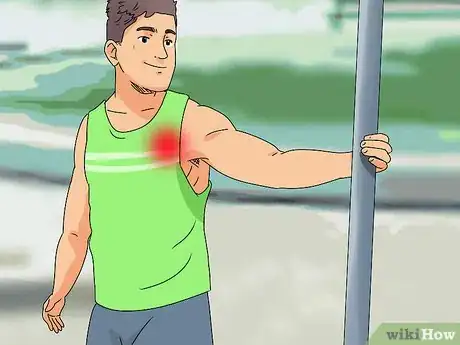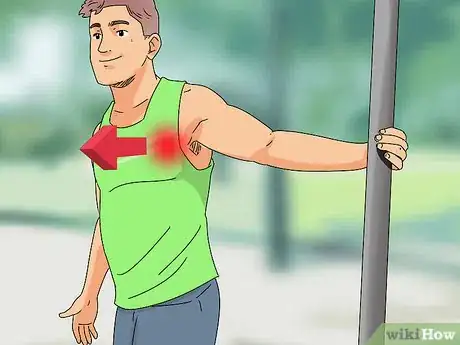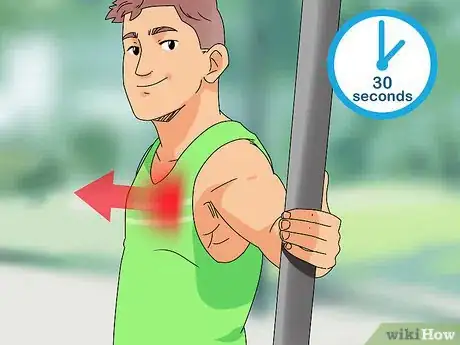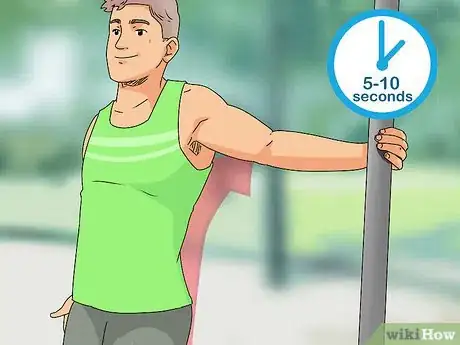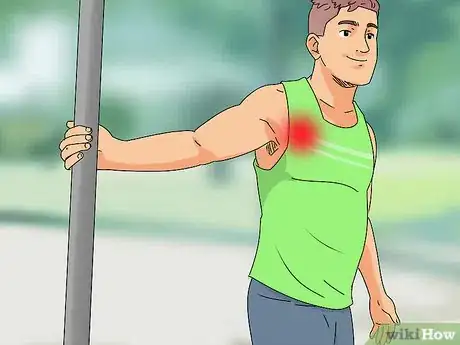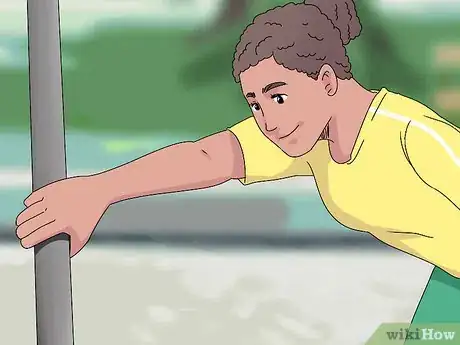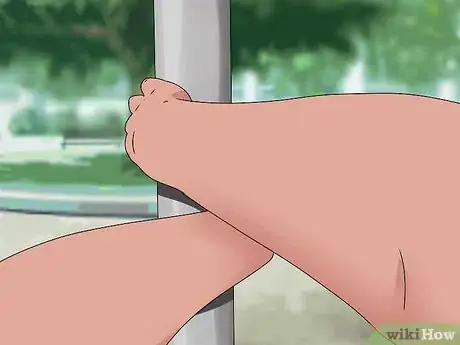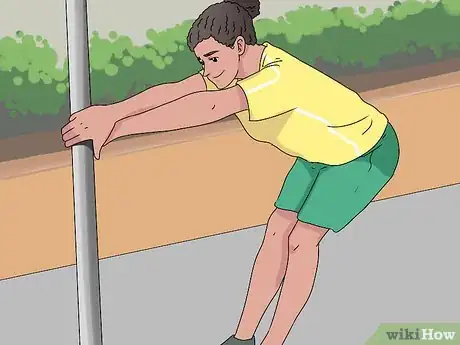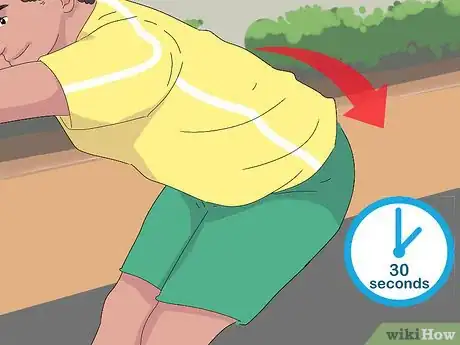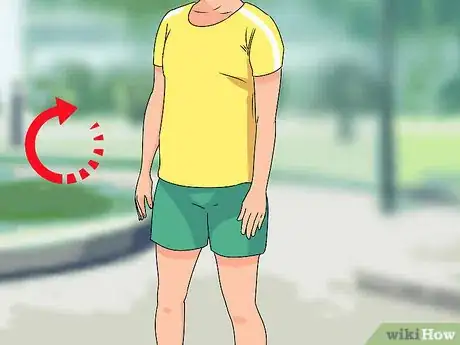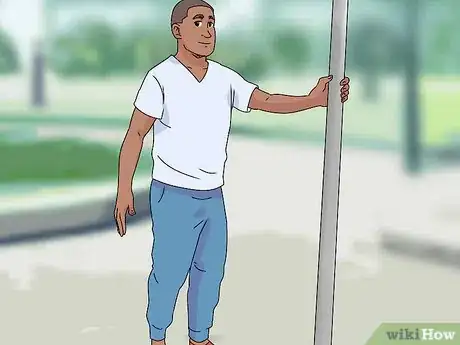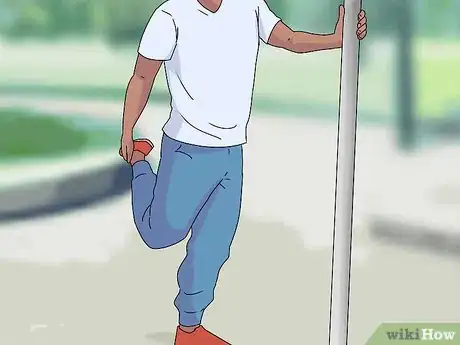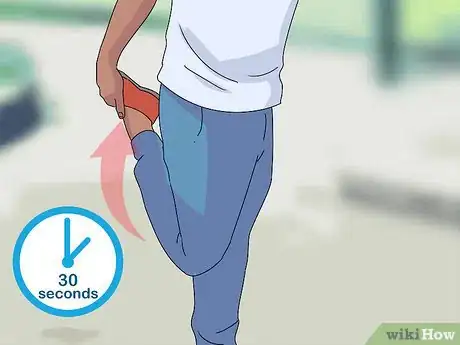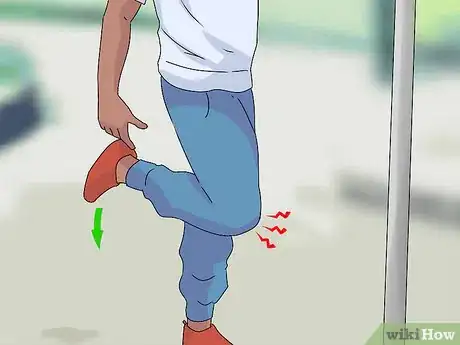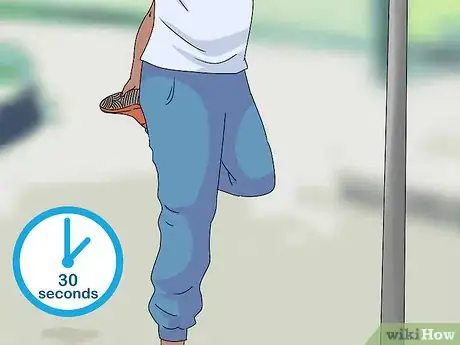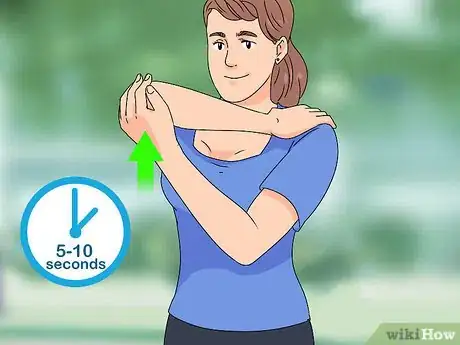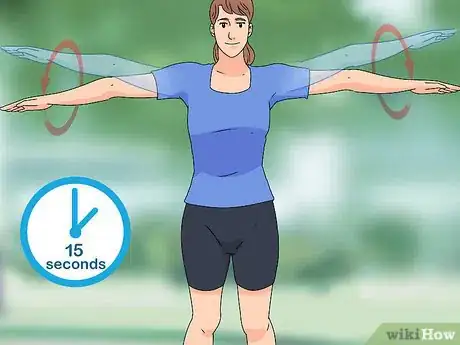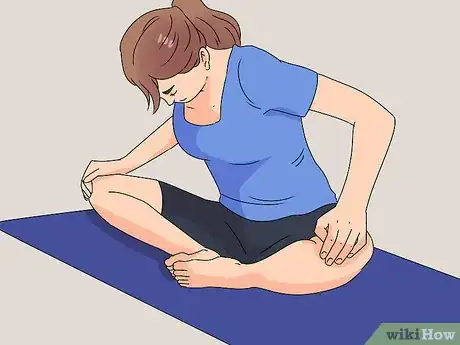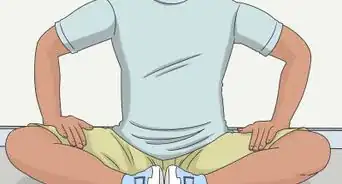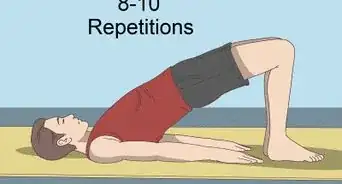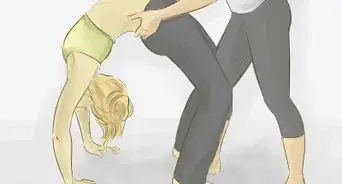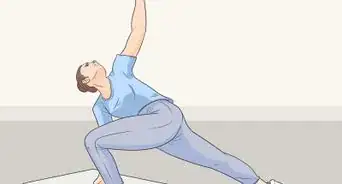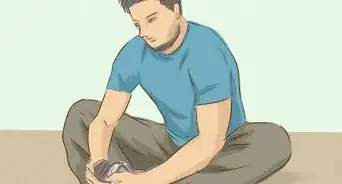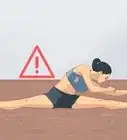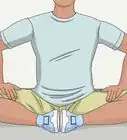This article was co-authored by Luba Lee, FNP-BC, MS. Luba Lee, FNP-BC is a Board-Certified Family Nurse Practitioner (FNP) and educator in Tennessee with over a decade of clinical experience. Luba has certifications in Pediatric Advanced Life Support (PALS), Emergency Medicine, Advanced Cardiac Life Support (ACLS), Team Building, and Critical Care Nursing. She received her Master of Science in Nursing (MSN) from the University of Tennessee in 2006.
There are 15 references cited in this article, which can be found at the bottom of the page.
This article has been viewed 34,770 times.
Ligaments keep your bones connected to one another and help keep your skeleton stable. To do their job properly, ligaments need to maintain a certain degree of strength and length. Stretching your ligaments can help maintain elasticity and ensure that your limbs keep a good range of motion. It’s also a great way to prepare for a rigorous weight-lifting session. Ligaments only have a little give to them, though, so you need to stretch gently to avoid the risk of tearing and other injury.
Steps
Chest
-
1Grab onto an immobile vertical object with 1 hand to steady yourself. The object that you hold onto doesn’t matter, but it should be stationary, steady, and between waist and chest height. You’ll be using it to keep yourself steady as you perform the stretch. So, if you’re at the gym, grab onto the vertical bar on a weight machine. If you’re at home or at your office, grab onto the edge of a wall or door frame. You can even do this stretch outside by grabbing a tree or fencepost.[1]
- Keep the rest of your posture relatively straight, yet limber. Stand with your feet approximately shoulder-width apart. Do not lock your knees.
- The ligaments in your chest and the front of your upper body help hold your rib cage together and keep your shoulders and upper arms in place.
-
2Push your chest slowly forward while holding onto the bar. Shove your chest forward and lean your weight forward to place tension on 1 side of your chest and 1 shoulder. Continue stretching until the muscles on that side of your chest feel mild discomfort without feeling any pain. This position allows you to stretch ligaments in the chest, shoulders, and biceps.[2]
- By doing this stretch, you’re pushing these muscle groups to the extent of their natural range. Do not push them beyond this point, however, since doing so could cause pain and greater damage.
Advertisement -
3Stay in the position for 30 seconds to thoroughly stretch your ligaments. Continue leaning forward with 1 hand grasping a secure object for a full 30 seconds. Then, gradually lean back to adjust your position and return to an upright stance. For the first 15 to 20 seconds, this stance will stretch your muscles. During the final 10 to 15 seconds, the muscles will relax, and the connective ligaments beneath will begin to stretch.[3]
- If you feel pain at any point during the exercise, stop the stretch immediately.
Tip: Perform this stretch before each time you exercise your chest and shoulders if you’re concerned about muscle and ligament tightness. If you’re stretching chest ligaments to increase flexibility, try doing the stretch 3-4 times a week. For example, stretch once on Monday, Wednesday, and Friday.
-
4Lean back and gradually return to an upright stance. Do this over a period of 5–10 seconds rather than standing back up instantaneously. Sharp movements can actually cause damage to newly stretched ligaments! As you lean back, you’ll feel the muscles relax.[4]
- Stretching out these ligaments is a great way to begin a workout focusing on your chest, biceps, and shoulders.
- If your muscles and ligaments still feel tight and you suspect that they haven’t been fully stretched out, repeat the stretch 1 or 2 more times.
-
5Repeat the ligament stretch on the other side of your chest. Turn around 180° and grab the same steady object with your other hand. Then, lean forward again for another 30 seconds before relaxing and coming back up to a normal standing position. Other than switching up the hand you use, everything about this second stretch should be the same as the first.[5]
- Switching hands will allow you to stretch the ligaments in both shoulders, in both biceps, and on both sides of your chest.
Back
-
1Invert your dominant hand and grab onto a steady vertical surface. Turn your hand 180° so that it’s upside down. Cross your arm in front of your chest and grab onto the weight-machine bar. So, if you want to stretch the right-hand side of your back first, grip the bar on its left side. Conversely, if you’re stretching the left-hand side of your back, grab the bar on its right side.[6]
- If no gym equipment is available, choose another stationary, steady object, like the frame of an open door or the edge of a desk. Ideally, the object should also be between waist and chest height.
-
2Place your inverted non-dominant hand over your dominant hand. As you did with your dominant hand, invert your non-dominant hand by rotating it 180°. Reach around the object you’re holding onto and place this hand over your other hand. Stand with your knees slightly bent and your feet shoulder-width apart.[7]
- Because you’ll engage both sides of your back in this stretch, you will not need to switch hands at any point.
-
3Lean back by lowering your hips and shifting your weight back. Gently ease your legs and buttocks backwards and down, pushing them as far as they will go without causing pain. Your upper body will gradually move back away from the bar. Only push yourself to the end range of your back muscles. You should feel some muscle discomfort, but you should not feel any actual pain.[8]
- In this position, you’ll be stretching the tendons in your lats (back), shoulders, and hips. You should feel the muscles in these areas stretch as you move into position. This is a great way to warm up for a weight-lifting session that concentrates on your back.
- The “end range” refers to the point at which you feel strain in the surrounding muscle without feeling any pain. Never push yourself to the point of feeling pain. Overworking the area by stretching too far may cause the ligaments to tear.
-
4Keep your hips lowered for 30 seconds to stretch your back ligaments. Remaining in this leaning position for a full 30 seconds will ensure that you loosen and lightly stretch as many ligaments as possible. If you’re concerned that you may not be effectively stretching out your muscles and ligaments, try very lightly bouncing your hips up and down.[9]
- During the first 15 to 20 seconds, only the muscles in the targeted areas will stretch. Afterward, the muscles will relax, allowing the connected ligaments to stretch.
-
5Ease yourself back into an upright position over several seconds. Tense the muscles in your upper thighs and constrict your biceps to pull yourself back to an upright standing position. Do this slowly, over a period of 5–10 seconds.[10]
- Move slowly, as jerky movements could potentially cause injury.
Tip: It’s a good idea to stretch the ligaments in your back before any back-focused weight-lifting session. If you’re stretching to relieve ligament tightness, try doing the stretch once a day for 1-2 weeks or until the ligaments start to feel looser.
Knees
-
1Hold onto a steady vertical object with your left hand. If you’re at a gym, face a stretch bar or the vertical beam of a weight machine. Stand with your feet shoulder-width apart and your knees loose. Reach out and grab the stretch bar with your left hand. If you do not have a stretch bar, use the frame of an open door, the edge of a desk, or any other stationary, steady object between waist and chest height.[11]
- Start by stretching the ligaments in the right half of your lower body. Grab the stretch bar with your left hand to maintain proper balance.
- Later on, when you are stretching the ligaments in the left side of your lower body, you’ll grab the bar with your right hand.
-
2Bend your right leg back and hold your foot with your right hand. Slowly bend your right knee and lift your right foot toward your back. Keep bending your right leg until you reach the end of your leg’s natural bending range. Grasp your right foot with your right hand, and exert gentle pressure to bend your knee a little farther.[12]
- In this stance, you should be able to stretch ligaments in your quads (thighs) and knees. You should feel the muscles in both areas stretch to the point of mild discomfort, but not to the point of pain.
- Keep your back and left leg straight, but do not lock your left knee. Every part of your body other than your lower right leg should continue facing the bar.
-
3Continue to exert slight pressure on your bent knee for 30 seconds. Keep your leg bent back for 30 seconds to ensure that the complex ligaments in your knee get a full stretch. Then, gradually lower your bent leg back down to the floor. The first 15 to 20 seconds of the stretch will target the muscles, but afterward, the muscles will relax and the ligaments will begin to stretch.[13]
- Avoid making sudden or jerky movements when you lower your leg, since they may cause more damage to the area.
Tip: Do this stretch once or twice a day in order to encourage flexibility in the ligaments of your knee. Otherwise, stretch like this before each workout session if you’re loosening up your quads and knee ligaments prior to a leg-intensive workout.
-
4Stop stretching if you feel any acute pain in your knees. If you really yank on your foot while attempting to stretch the ligaments in your quads and knees, you could tear the ligament in half. Not only is this very painful, but a torn ligament takes months to heal. Excessive and frequent ligament stretching can be counterproductive and can in fact weaken the joints that you’ve stretched.[14]
- Ligaments are not meant to stretch far. In fact, most ligaments can only stretch until they’re about 6% longer than their resting length.
-
5Repeat the stretch with your right hand and left leg. Repeat the same steps as before, but this time grasp the bar with your left hand and bend your left leg. Lightly pull upwards on your left foot until it’s stretched as far as it normally bends. Hold your leg in this position for 30 seconds, and gradually release it.[15]
- Switching sides will allow you to target and stretch the ligaments in both legs. This is a great stretch to perform before working out your legs.
Other Joints
-
1Bend 1 arm at the elbow to stretch ligaments around your shoulders. Start by bending your right arm and placing your right hand on your left shoulder. Then, grasp your right elbow with your left hand. Push upwards so that your elbow nearly touches your face. Continue to press upwards until you feel the muscles around your shoulder stretch. Keep the shoulder in this position for 5–10 seconds, then slowly release it.[16]
- Repeat the stretch with your left arm. Place your left hand on your right shoulder and use your right hand to press the left elbow up towards your face.
- This stretch also works to stretch out ligaments on the sides of your chest that other stretches can’t quite reach. Avoid over-extending the ligaments or you’ll experience sharp pain.
- The ligaments in your shoulder can be strained easily. To avoid damaging them, use this stretch only once or twice per week. Continue stretching your shoulder for as long as you continue experiencing restricted movement in the ligaments.
-
2Lengthen ligaments in your upper chest with your arms extended. If you’re experiencing pain in the ligaments in your shoulders or around your collar bone, stand upright with both arms outstretched. Slowly rotate your arms in full clockwise circles for 15 seconds. Then reverse the direction and move your arms in counterclockwise circles for another 15 seconds.[17]
- If you don’t feel much of a stretch at first, try rotating your arms in larger circles. For example, hold your arms high so they’re nearly vertical and then rotate them until they’re pointing to the ground.
- To help permanently loosen the ligaments in your upper chest, try doing this exercise one time a day, 2-3 days a week.
-
3Stretch the ligaments in your hips and pelvis from a seated position. Sit down on the floor and place the soles of your feet together. Lean your knees outwards (away from your feet) as far as they can comfortably go. Lean forward from your waist until you feel strain on the ligaments around your pelvis and hips. After 3–5 seconds pass, gradually relax the joint and return it to its resting position.[18]
- Avoid leaning forward from your back. This won’t put much strain on the ligaments. Also avoid making sharp or quick motions as you’re doing this stretch.
- You can perform this stretch as often as you like, as long as you don’t experience pain in your pelvis. Try doing the stretch once or twice daily, 4-5 days a week, or until your hips start to feel more flexible.
EXPERT TIPAlyssa Chang is a nutrition coach and trainer, based in the San Francisco Bay Area. She uses her extensive background in brain-based neuroscience to work with clients on improving their connections with their brain and body to heal, reach goals, and move pain-free. She holds a BS in Kinesiology and Exercise, Nutrition and Wellness from the California State University, East Bay and is certified in Precision Nutrition, Z-health Performance and is certified by the National Council for Strength and Fitness.Wellness Coach & Personal Trainer
 Alyssa Chang
Alyssa Chang
Wellness Coach & Personal TrainerIf you're having problems with tightness in your ligaments, talk to your doctor about potential underlying issues. Muscle tightness, ligament tightness, and things like that are all potentially secondary effects from something else going on within your nervous system and your body. For instance, if you have a problem in your inner ear, it can affect your balance and coordination. As a result, you might notice rigidity and stiffness, which is your body's attempt to protect itself.
-
4Use a foam roller to gently stretch tight ligaments. Foam rollers are great for releasing muscle tension and increasing the flexibility of all kinds of tissues in your body, including ligaments. Target areas that feel stiff and tight, and slowly roll the affected part of your body back and forth over the roller for 30-60 seconds.[19] You can buy a foam roller in the sporting goods section of most department stores.
- For instance, to gently stretch the ligaments in your shoulder, get down on all fours with the roller under the arm you plan to stretch. Extend your arm across your chest to the opposite side of your body so that the roller moves along the length of your arm toward your shoulder. Hold your position for 2-5 seconds before rolling your arm back the other way.
- You can also use a foam roller to assist you with other types of stretches. For example, to stretch the ligaments in your knees, lie on your back with the foam roller under your knees and your heels on the floor. Tighten your thigh muscle to gently straighten the affected leg as much as possible. Hold your knee straight for about 6 seconds before slowly lowering your heel to the floor again.
-
5Massage tense areas with your hands. Self-massage is a great way to release tension in your muscles, which will also help reduce strain on your tendon and ligaments.[20] Use your thumbs or knuckles to gently press, knead, or stroke areas where you feel tension. You can also use a tennis ball, massage ball, or massage roller for a more intense or targeted massage, or to reach more difficult areas (like your back).
- Self-massage is safe for most people, but ask your doctor if you have any concerns. For instance, they may recommend that you avoid massage if you have any blood clots or injuries in the affected area.
- Your doctor or physical therapist can also give you tips on the best type of massage for specific areas (such as your shoulders or knees).
Warnings
- Talk to your doctor, fitness instructor, or physical therapist before making the decision to routinely stretch your ligaments, especially if you plan to do so after an injury or limb trauma. If you stretch and lengthen your ligaments too much, you can actually weaken and destabilize the related joints and muscle groups.[25]⧼thumbs_response⧽
- If you’re experiencing a loss of mobility or joint stiffness, focus on a stretch that targets the joint in question. For example, if you’re experiencing a loss of movement in your shoulder and wish to target the ligaments there, do stretches that specifically target the shoulder.⧼thumbs_response⧽
References
- ↑ https://youtu.be/M39zIJk6QMk?t=37
- ↑ https://youtu.be/M39zIJk6QMk?t=39
- ↑ https://www.expandinglight.org/free/yoga-teacher/articles/yoga-therapy/stretch-ligaments.php
- ↑ https://www.expandinglight.org/free/yoga-teacher/articles/yoga-therapy/stretch-ligaments.php
- ↑ https://youtu.be/M39zIJk6QMk?t=53
- ↑ https://youtu.be/M39zIJk6QMk?t=67
- ↑ https://youtu.be/M39zIJk6QMk?t=68
- ↑ https://youtu.be/M39zIJk6QMk?t=71
- ↑ https://youtu.be/M39zIJk6QMk?t=80
- ↑ https://www.expandinglight.org/free/yoga-teacher/articles/yoga-therapy/stretch-ligaments.php
- ↑ https://youtu.be/M39zIJk6QMk?t=95
- ↑ https://youtu.be/M39zIJk6QMk?t=95
- ↑ https://www.expandinglight.org/free/yoga-teacher/articles/yoga-therapy/stretch-ligaments.php
- ↑ http://web.mit.edu/tkd/stretch/stretching_3.html
- ↑ https://youtu.be/M39zIJk6QMk?t=108
- ↑ https://www.sportsrec.com/338028-how-to-stretch-ligaments-tendons.html
- ↑ https://www.sportsrec.com/338028-how-to-stretch-ligaments-tendons.html
- ↑ https://www.sportsrec.com/338028-how-to-stretch-ligaments-tendons.html
- ↑ https://www.acefitness.org/education-and-resources/lifestyle/blog/5624/foam-rolling-101/
- ↑ https://www.mayoclinic.org/healthy-lifestyle/stress-management/in-depth/massage/art-20045743
- ↑ http://web.mit.edu/tkd/stretch/stretching_3.html
- ↑ https://www.expandinglight.org/free/yoga-teacher/articles/yoga-therapy/stretch-ligaments.php
- ↑ https://www.expandinglight.org/free/yoga-teacher/articles/yoga-therapy/stretch-ligaments.php
- ↑ https://medlineplus.gov/ency/imagepages/19089.htm
- ↑ http://web.mit.edu/tkd/stretch/stretching_3.html
